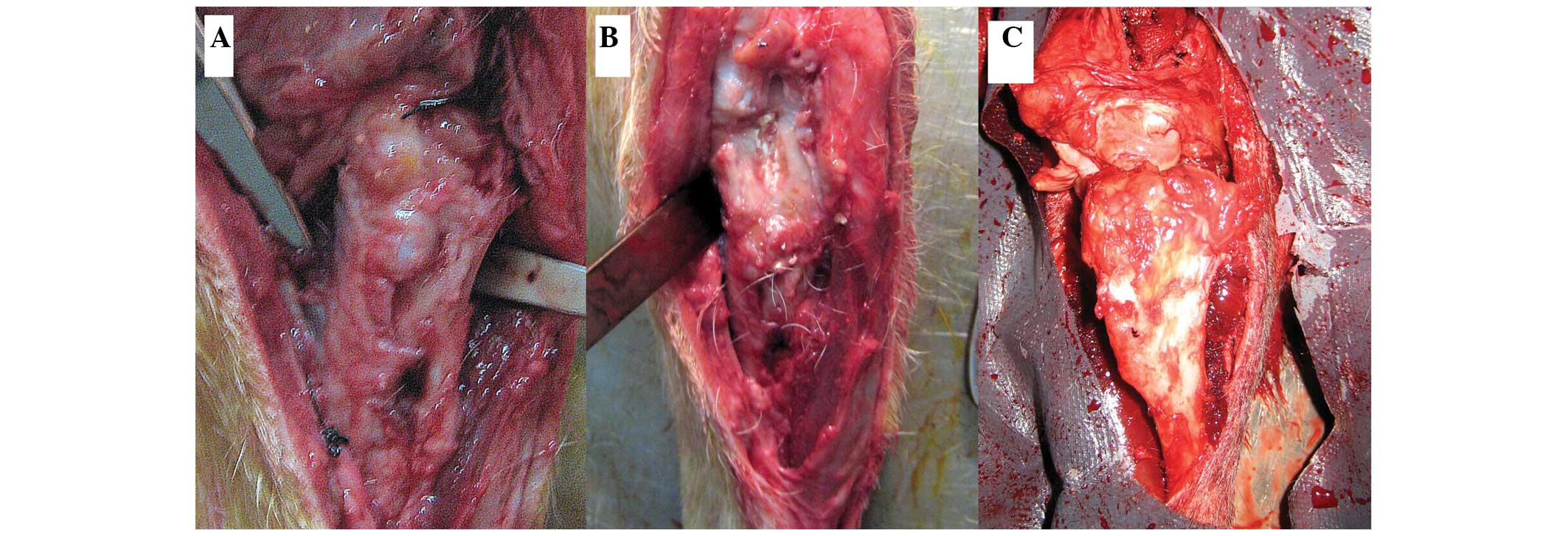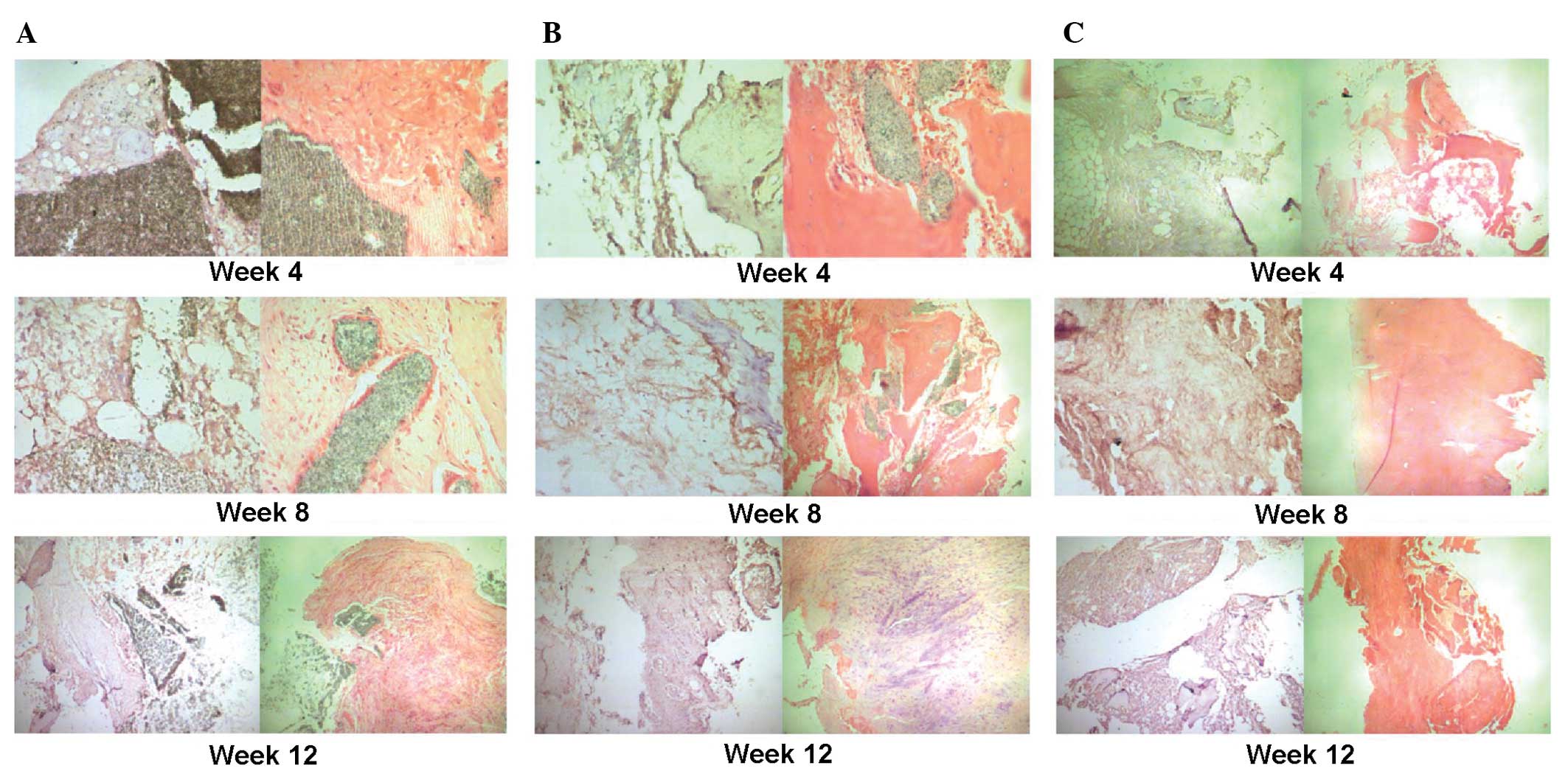|
1
|
Gafni Y, Turgeman G, Liebergal M, et al:
Stem cells as vehicles for orthopedic gene therapy. Gene Ther.
11:417–426. 2004. View Article : Google Scholar : PubMed/NCBI
|
|
2
|
Park KW, Eglitis MA and Mouradian MM:
Protection of nigral neurons by GDNF-engineered marrow cell
transplantation. Neurosci Res. 40:315–323. 2001. View Article : Google Scholar : PubMed/NCBI
|
|
3
|
Wiltfang J, Merten HA, Schlegel KA, et al:
Degradation characteristics of alpha and beta tri-calcium-phosphate
(TCP) in minipigs. J Biomed Mater Res. 63:115–121. 2002. View Article : Google Scholar : PubMed/NCBI
|
|
4
|
Yamada Y, Boo JS, Ozawa R, et al: Bone
regeneration following injection of mesenchymal stem cells and
fibrin glue with a biodegradable scaffold. J Craniomaxillofac Surg.
31:27–33. 2003. View Article : Google Scholar : PubMed/NCBI
|
|
5
|
Cao H and Kuboyama N: A biodegradable
porous composite scaffold of PGA/beta-TCP for bone tissue
engineering. Bone. 46:386–395. 2010. View Article : Google Scholar : PubMed/NCBI
|
|
6
|
Anitua E: Plasma rich in growth factors:
preliminary results of use in the preparation of future sites for
implants. Int J Oral Maxillofac Implants. 14:529–535.
1999.PubMed/NCBI
|
|
7
|
Carlson NE and Roach RB Jr: Platelet-rich
plasma: clinical applications in dentistry. J Am Dent Assoc.
133:1383–1386. 2002. View Article : Google Scholar : PubMed/NCBI
|
|
8
|
Huang S and Wang Z: Platelet-rich
plasma-derived growth factors promote osteogenic differentiation of
rat muscle satellite cells: in vitro and in vivo studies. Cell Biol
Int. 36:1195–1205. 2012. View Article : Google Scholar : PubMed/NCBI
|
|
9
|
Formigli L, Benvenuti S, Mercatelli R, et
al: Dermal matrix scaffold engineered with adult mesenchymal stem
cells and platelet-rich plasma as a potential tool for tissue
repair and regeneration. J Tissue Eng Regen Med. 6:125–134. 2012.
View Article : Google Scholar : PubMed/NCBI
|
|
10
|
Schuckert KH, Jopp S and Teoh SH:
Mandibular defect reconstruction using three-dimensional
polycaprolactone scaffold in combination with platelet-rich plasma
and recombinant human bone morphogenetic protein-2: de novo
synthesis of bone in a single case. Tissue Eng Part A. 15:493–499.
2009. View Article : Google Scholar
|
|
11
|
Yoshimi R, Yamada Y, Ito K, et al:
Self-assembling peptide nanofiber scaffolds, platelet-rich plasma,
and mesenchymal stem cells for injectable bone regeneration with
tissue engineering. J Craniofac Surg. 20:1523–1530. 2009.
View Article : Google Scholar : PubMed/NCBI
|
|
12
|
Kon E, Filardo G, Delcogliano M, et al:
Platelet autologous growth factors decrease the osteochondral
regeneration capability of a collagen-hydroxyapatite scaffold in a
sheep model. BMC Musculoskelet Disord. 11:2202010. View Article : Google Scholar : PubMed/NCBI
|
|
13
|
Kasten P, Vogel J, Luginbühl R, et al:
Influence of platelet-rich plasma on osteogenic differentiation of
mesenchymal stem cells and ectopic bone formation in calcium
phosphate ceramics. Cells Tissues Organs. 183:68–79. 2006.
View Article : Google Scholar : PubMed/NCBI
|
|
14
|
van den Dolder J, Mooren R, Vloon AP,
Stoelinga PJ and Jansen JA: Platelet-rich plasma: quantification of
growth factor levels and the effect on growth and differentiation
of rat bone marrow cells. Tissue Eng. 12:3067–3073. 2006.PubMed/NCBI
|
|
15
|
Tajima N, Sotome S, Marukawa E, Omura K
and Shinomiya K: A three-dimensional cell-loading system using
autologous plasma loaded into a porous β-tricalcium-phosphate block
promotes bone formation at extraskeletal sites in rats. Materials
Science and Engineering C. 27:625–632. 2007.
|
|
16
|
Jiang ZQ, Liu HY, Zhang LP, Wu ZQ and
Shang DZ: Repair of calvarial defects in rabbits with platelet-rich
plasma as the scaffold for carrying bone marrow stromal cells. Oral
Surg Oral Med Oral Pathol Oral Radiol. 113:327–333. 2012.
View Article : Google Scholar : PubMed/NCBI
|
|
17
|
Shim JH, Moon TS, Yun MJ, et al:
Stimulation of healing within a rabbit calvarial defect by a
PCL/PLGA scaffold blended with TCP using solid freeform fabrication
technology. J Mater Sci Mater Med. 23:2993–3002. 2012. View Article : Google Scholar : PubMed/NCBI
|
|
18
|
Hao W, Pang L, Jiang M, Lv R, Xiong Z and
Hu YY: Skeletal repair in rabbits using a novel biomimetic
composite based on adipose-derived stem cells encapsulated in
collagen I gel with PLGA-beta-TCP scaffold. J Orthop Res.
28:252–257. 2010.PubMed/NCBI
|
|
19
|
Lucarelli E, Fini M, Beccheroni A, et al:
Stromal stem cells and platelet-rich plasma improve bone allograft
integration. Clin Orthop Relat Res. 62–68. 2005. View Article : Google Scholar : PubMed/NCBI
|
|
20
|
Kovács K, Velich N, Huszár T, Fenyves B,
Suba Z and Szabó G: Histomorphometric and densitometric evaluation
of the effects of platelet-rich plasma on the remodeling of
beta-tricalcium phosphate in beagle dogs. J Craniofac Surg.
16:150–154. 2005.PubMed/NCBI
|
|
21
|
Noël D, Gazit D, Bouquet C, et al:
Short-term BMP-2 expression is sufficient for in vivo osteochondral
differentiation of mesenchymal stem cells. Stem Cells. 22:74–85.
2004.PubMed/NCBI
|
|
22
|
Mauney JR, Volloch V and Kaplan DL:
Matrix-mediated retention of adipogenic differentiation potential
by human adult bone marrow-derived mesenchymal stem cells during ex
vivo expansion. Biomaterials. 26:6167–6175. 2005. View Article : Google Scholar
|
|
23
|
Friedman MS, Long MW and Hankenson KD:
Osteogenic differentiation of human mesenchymal stem cells is
regulated by bone morphogenetic protein-6. J Cell Biochem.
98:538–554. 2006. View Article : Google Scholar : PubMed/NCBI
|
|
24
|
Marx RE, Carlson ER, Eichstaedt RM,
Schimmele SR, Strauss JE and Georgeff KR: Platelet-rich plasma:
Growth factor enhancement for bone grafts. Oral Surg Oral Med Oral
Pathol Oral Radiol Endod. 85:638–646. 1998. View Article : Google Scholar : PubMed/NCBI
|
|
25
|
Fennis JP, Stoelinga PJ and Jansen JA:
Mandibular reconstruction: a histological and histomorphometric
study on the use of autogenous scaffolds, particulate
cortico-cancellous bone grafts and platelet rich plasma in goats.
Int J Oral Maxillofac Surg. 33:48–55. 2004. View Article : Google Scholar : PubMed/NCBI
|
|
26
|
Arpornmaeklong P, Kochel M, Depprich R, et
al: Influence of platelet-rich plasma (PRP) on osteogenic
differentiation of rat bone marrow stromal cells. An in vitro
study. Int J Oral Maxillofac Surg. 33:60–70. 2004. View Article : Google Scholar : PubMed/NCBI
|
|
27
|
Lohfeld S, Cahill S, Barron V, et al:
Fabrication, mechanical and in vivo performance of
polycaprolactone/tricalcium phosphate composite scaffolds. Acta
Biomater. 8:3446–3456. 2012. View Article : Google Scholar : PubMed/NCBI
|














